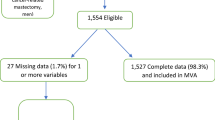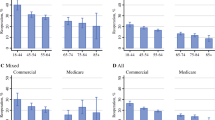Abstract
Background: Medicare determines procedural reimbursement by means of formulas considering physician work, practice, and liability expenses. Since no mechanism exists to consider outcomes in calculating reimbursements, we hypothesized that Medicare reimbursements do not correlate with outcomes for different breast cancer operations.
Methods: We prospectively studied 240 patients with T1, 2N0M0 breast cancer in three surgical treatment arms: segmental mastectomy with axillary node dissection (SM&ALND n = 42); SM with sentinel node dissection (SM&SLND n = 96); and mastectomy without reconstruction (MRM; n = 102). Outcome parameters of complications, hospital stay, analgesic usage, and days to return to work were correlated with procedure reimbursements.
Results: Median follow-up was 26 months. SM&SLND patients rarely required hospital stays (14%) in comparison with either SM&ALND (96%) or MRM patients (99%) (P < 0.001). SM&ALND and MRM patients required 9 and 10 median days of narcotics, respectively, versus 1 day in the SLND group (P < 0.001). SM&SLND patients returned to work at a median of 3 days, in comparison with 19 for SM&ALND and 26 for MRM patients (P < 0.001). Complications were more common in the MRM group (67% numbness/10% pain) and the SM&ALND group (56%/9%) than in the SM&SLND group (0%/1%). Reimbursements were inversely correlated with outcomes. MRM was reimbursed the highest, at an average of $1,075.03, with SM&ALND at $882.72. SM&SLND was reimbursed at $642.00.
Conclusions: Medicare reimbursements for breast cancer operations do not correlate with outcomes. Less-invasive procedures are paid for at lower rates despite better outcomes and fewer complications. The data from this study raise the question of the impact of reimbursement on breast procedure selection.
Similar content being viewed by others
REFERENCES
van Dongen JA, Bartelink H, Fentiman IS, et al. Factors influencing local relapse and survival and results of salvage treatment after breast-conserving therapy in operable breast cancer: EORTC trial 10801, breast conservation compared with mastectomy in TNM stage I and II breast cancer. Eur J Cancer 1992; 28A:801–5.
Veronesi U, Saccozzi R, Del Vecchio M, et al. Comparing radical mastectomy with quadrantectomy, axillary dissection, and radiotherapy in patients with small cancers of the breast. N Engl J Med 1981; 305:6–11.
Sarrazin D, Le MG, Arriagada R, et al. Ten-year results of a randomized trial comparing a conservative treatment to mastectomy in early breast cancer. Radiother Oncol 1989; 14:177–84.
Lichter AS, Lippman ME, Danforth DN Jr, et al. Mastectomy versus breast-conserving therapy in the treatment of stage I and II carcinoma of the breast: a randomized trial at the National Cancer Institute. J Clin Oncol 1992; 10:976–83.
Fisher B, Redmond C, Poisson R, et al. Eight-year results of a randomized clinical trial comparing total mastectomy and lumpectomy with or without irradiation in the treatment of breast cancer. N Engl J Med 1989; 320:822–8.
Fisher B, Anderson S, Bryant J, et al. Twenty-year follow-up of a randomized trial comparing total mastectomy, lumpectomy, and lumpectomy plus irradiation for the treatment of invasive breast cancer. N Engl J Med 2002; 347:1233–41.
Blichert-Toft M, Brincker H, Andersen JA, et al. A Danish randomized trial comparing breast-preserving therapy with mastectomy in mammary carcinoma. Preliminary results. Acta Oncol 1988; 27:671–7.
Centers for Medicare and Medicaid Services. http://www.cms.hhs.gov/physicians/mpfsapp/step0.asp.
Giuliano AE. See one, do twenty-five, teach one: the implementation of sentinel node dissection in breast cancer. Ann Surg Oncol 1999; 6:520–1.
Simmons RM. Review of sentinel lymph node credentialing: how many cases are enough? J Am Coll Surg 2001; 193:206–9.
McMasters KM, Wong SL, Chao C, et al. Defining the optimal surgeon experience for breast cancer sentinel lymph node biopsy: a model for implementation of new surgical techniques. Ann Surg 2001; 234:292–9;discussion, 299–300.
Kane JM 3rd, Edge SB, Winston JS, et al. Intraoperative pathologic evaluation of a breast cancer sentinel lymph node biopsy as a determinant for synchronous axillary lymph node dissection. Ann Surg Oncol 2001; 8:361–7.
Rubio IT, Korourian S, Cowan C, et al. Use of touch preps for intraoperative diagnosis of sentinel lymph node metastases in breast cancer. Ann Surg Oncol 1998; 5:689–94.
The American Society of Breast Surgeons. www.breastsurgeons.com.
Hadley J, Mandelblatt JS, Mitchell JM, et al. Medicare breast surgery fees and treatment received by older women with localized breast cancer. Health Serv Res 2003; 38:553–73.
Howisey RL, Acheson MB, Rowbotham RK, et al. A comparison of Medicare reimbursement and results for various imaging-guided breast biopsy techniques. Am J Surg 1997; 173:395–8.
McKee MD, Cropp MD, Hyland A, et al. Provider case volume and outcome in the evaluation and treatment of patients with mammogram-detected breast carcinoma. Cancer 2002; 95:704–12.
Osteen RT, Karnell LH. The National Cancer Data Base report on breast cancer. Cancer 1994; 73:1994–2000.
Morrow M, White J, Moughan J, et al. Factors predicting the use of breast-conserving therapy in stage I and II breast carcinoma. J Clin Oncol 2001; 19:2254–62.
Locker GSR, Cuzick J. Breast surgery in the ATAC trial: women from the United States are more likely to have mastectomy. Breast Cancer Res Treatment 2002; 76:S27.
Lee-Feldstein A, Feldstein PJ, Buchmueller T, et al. Breast cancer outcomes among older women: HMO, fee-for-service, and delivery system comparisons. J Gen Intern Med 2001; 16:189–99.
Michalski TA, Nattinger AB. The influence of black race and socioeconomic status on the use of breast-conserving surgery for Medicare beneficiaries. Cancer 1997; 79:314–9.
Lee-Feldstein A, Anton-Culver H, Feldstein PJ. Treatment differences and other prognostic factors related to breast cancer survival. Delivery systems and medical outcomes. JAMA 1994; 271:1163–8.
Roetzheim RG, Gonzalez EC, Ferrante JM, et al. Effects of health insurance and race on breast carcinoma treatments and outcomes. Cancer 2000; 89:2202–13.
Author information
Authors and Affiliations
Corresponding author
Rights and permissions
About this article
Cite this article
Lucci, A., Shoher, A., Sherman, M.O. et al. Assessment of the Current Medicare Reimbursement System for Breast Cancer Operations. Ann Surg Oncol 11, 1037–1044 (2004). https://doi.org/10.1245/ASO.2004.03.034
Received:
Accepted:
Issue Date:
DOI: https://doi.org/10.1245/ASO.2004.03.034




